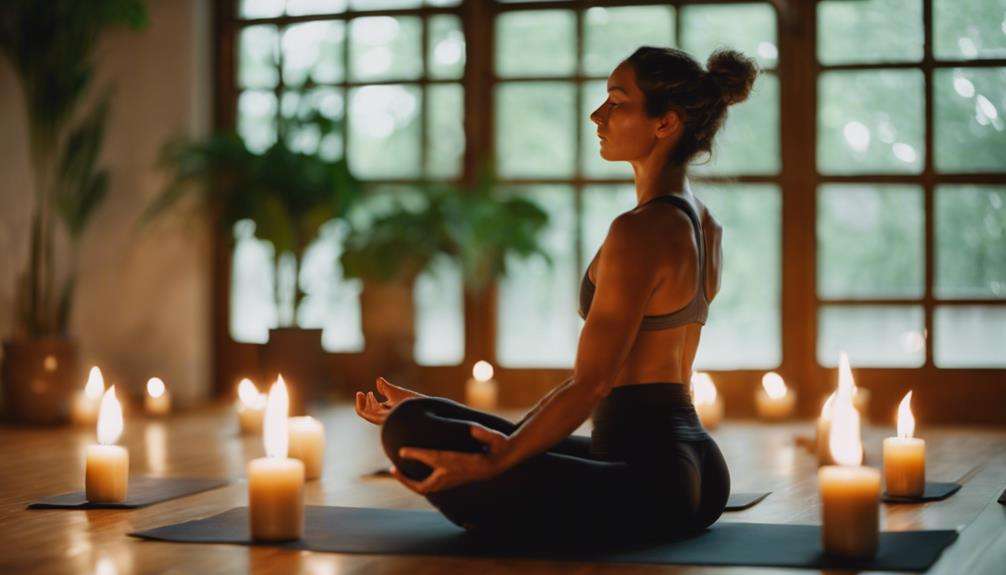Embarking on the journey of mastering mindfulness through yoga grounding techniques is akin to setting sail on a sea of tranquility. As you navigate the tumultuous waters of a fast-paced world, these seven techniques serve as anchors to tether you to the present moment and quiet the storm within.
Each method offers a unique path to stillness and clarity, guiding you towards a deeper understanding of self-awareness and inner peace. Discover the transformative power these practices hold and unlock the potential for profound growth in your mindfulness journey.
Key Takeaways
- Focus on the Breath for grounding and mindfulness in yoga practice.
- Use Body Scan Exercise to deepen self-awareness and presence.
- Incorporate Mindful Walking for heightened sensory experience and focus.
- Engage in Mantra Repetition to cultivate inner peace and mental clarity.
Common Difficulties in Mindfulness Practice
Navigating through mindfulness practice can be challenging, as common difficulties such as a wandering mind and distractions often hinder your journey towards presence and peace. Your mind may resemble a 'monkey mind,' swinging from one thought to another, making it hard to stay grounded in the present moment. Internal resistance and a lack of focus can further complicate your practice, leading to moments of restlessness and impatience.
Distractions, both internal and external, can pull you away from the mindfulness path you're trying to follow. It's important to acknowledge these challenges and understand that they're a natural part of the journey towards a more mindful existence. By recognizing and addressing these common difficulties, you can develop strategies to overcome them and enhance your mindfulness practice.
Monkey Mind Grounding Techniques
Feeling overwhelmed by your wandering thoughts and distractions in mindfulness practice? Let's explore effective Monkey Mind Grounding Techniques to help you find peace and focus in the present moment.
- Focus on the Breath: When your monkey mind starts chattering, bring your attention to your breath. Notice the inhales and exhales, allowing this simple act to anchor you in the present moment.
- Body Scan Exercise: Conduct a body scan by slowly focusing on each body part. This grounding exercise can redirect your attention away from chaotic thoughts and towards physical sensations, promoting calmness.
- Mindful Walking: Engage in mindful walking by paying attention to each step you take. This practice can help break the cycle of mental chatter and bring you back to the present moment.
- Mantra Repetition: Repeat a calming mantra or phrase to yourself. This technique can provide a focal point for your mind, reducing stress and enhancing mental clarity.
Drifting Thoughts Awareness Exercise

As you engage in the Drifting Thoughts Awareness Exercise, remember to focus on your breath, acknowledge any distractions that arise, and gently guide your attention back to the present moment.
By practicing this exercise, you can cultivate a deeper understanding of your thought patterns and enhance your self-awareness.
Embrace this practice as a powerful tool to ground your mind and foster a sense of clarity and presence in your daily life.
Focus on Breath
When practicing the Focus on Breath, also known as the Drifting Thoughts Awareness Exercise, you observe your thoughts without judgment during meditation. This exercise helps you cultivate a sense of balance and inner peace by focusing on your breath.
Here are some key points to keep in mind:
- Breathing Exercises: Engage in intentional inhales and exhales to anchor yourself in the present moment.
- Mindful Technique: Use the breath as a focal point to enhance concentration and awareness.
- Balancing Act: Find equilibrium by acknowledging drifting thoughts without getting entangled in them.
- Nervous System Support: Regulate your nervous system by staying attuned to the rhythm of your breath.
Acknowledge Distractions
To deepen your mindfulness practice, acknowledge distractions as part of the Drifting Thoughts Awareness Exercise, fostering awareness and enhancing your focus.
When you notice your mind drifting away from the present moment, take a moment to acknowledge the distraction without judgment. By incorporating this practice into your grounding techniques, you strengthen your mindfulness and cultivate a deeper understanding of your mental patterns.
The Drifting Thoughts Awareness Exercise allows you to observe wandering thoughts, bringing your attention back to the present. Through this exercise, you can notice distractions as they arise, without getting entangled in them.
Embrace this opportunity to sharpen your focused attention and develop a greater sense of clarity in your mindfulness practice.
Return to Present
Practice the Drifting Thoughts Awareness Exercise to gently guide your focus back to the present moment, fostering mindfulness and self-awareness.
- Acknowledge your drifting thoughts without judgment.
- Recognize that wandering thoughts are natural during mindfulness practice.
- Refocus your attention on the present moment by noticing these drifting thoughts.
- Cultivate self-awareness and enhance your ability to let go of distractions.
Object of Focus Attention Technique

By focusing your attention on a physical object, the Object of Focus Attention Technique can serve as a powerful tool for grounding your awareness and fostering mindfulness. This method allows you to direct your focus onto a tangible item, helping to anchor your mind in the present moment.
As you concentrate on the object, distractions fade away, enabling a sense of calm and presence to emerge within you. By practicing this technique, you can enhance your concentration, alleviate anxiety, and establish a deeper connection with the present moment.
Regular use of the Object of Focus Attention Technique can strengthen your ability to remain grounded and centered in various situations, providing you with a reliable anchor amidst life's challenges. Embrace this practice with openness and dedication, allowing it to guide you towards a state of heightened mindfulness and inner tranquility.
Body Scan for Grounding
Begin your journey towards grounding and mindfulness with the transformative practice of the body scan technique. This powerful method allows you to cultivate awareness, relaxation, and grounding in the present moment. Whether you choose to do a body scan lying down or sitting comfortably, the process involves focusing your attention on different parts of your body, starting from your toes and slowly moving upwards.
Here's how the body scan technique can benefit you:
- Enhanced Self-Awareness: By systematically scanning your body, you develop a deeper connection with yourself and your physical sensations.
- Stress Reduction: The body scan helps release tension, allowing you to let go of stress and promote relaxation.
- Improved Well-Being: Practicing body scans regularly can enhance your overall well-being by bringing your mind and body into harmony.
- Mind-Body Connection: This technique strengthens the connection between your physical body and your mental state, fostering a deeper sense of grounding.
Breath-Focused Mindfulness Practice

As you begin exploring breath-focused mindfulness practice, you'll find that deepening your breath awareness is a powerful tool for grounding.
By directing your attention to the natural rhythm of your breath, you can experience a host of benefits tied to focused breathing.
Embracing this practice can help calm your mind, reduce stress, and enhance your ability to stay present in the moment.
Deepening Breath Awareness
Enhance your mindfulness practice by deepening your breath awareness through focused attention on each inhale and exhale.
- Focus on Sensation: Notice the feeling of air entering and leaving your body, bringing your awareness to the physical sensations of each breath.
- Stay Present: Let go of distractions and worries by centering your mind on the rhythm of your inhales and exhales, anchoring yourself in the present moment.
- Cultivate Inner Peace: Embrace the stillness within as you deepen your breath awareness, allowing a sense of calm to permeate your being.
- Enhance Mindfulness Practice: By honing in on your breath, you pave the way for improved concentration, emotional balance, and self-understanding.
Benefits of Focused Breathing
Deepening your breath awareness through focused attention can unlock a multitude of benefits in your mindfulness practice, especially when it comes to the practice of breath-focused mindfulness. By honing in on your breath, you enhance concentration and heighten your awareness of the present moment.
This focused breathing technique promotes relaxation, soothing the nervous system and reducing stress levels effectively. Moreover, engaging in breath-focused mindfulness can aid in improving emotional regulation and sharpening decision-making skills.
The accessibility of this practice makes it a convenient tool for grounding and centering yourself whenever needed. Consistent practice of breath-focused mindfulness can ultimately lead to enhanced overall well-being and increased mental clarity, empowering you to navigate life with a sense of calm and purpose.
External Stimuli Awareness Method
To deepen your connection with the present moment, engage your senses fully through the External Stimuli Awareness Method. By immersing yourself in the sensory experiences around you, you can ground yourself in the here and now, fostering a profound sense of mindfulness and presence. Here's how to practice this method effectively:
- Listen: Pay attention to the sounds in your environment, whether it's the chirping of birds, the rustling of leaves, or the hum of traffic. Let these sounds anchor you to the present moment.
- Observe: Take in the sights that surround you, noticing the colors, shapes, and movements. Allow your visual perception to bring you into a state of heightened awareness.
- Smell and Taste: Engage your sense of smell and taste by noticing any scents or flavors in the air. Whether it's the aroma of flowers or the taste of your food, let these sensations ground you in the present.
- Touch: Feel the textures around you—whether it's the smooth surface of a stone, the warmth of the sun on your skin, or the softness of grass beneath your feet. Connect with these tactile sensations to deepen your mindfulness practice.
Frequently Asked Questions
How Do You Practice Grounding and Mindfulness?
To practice grounding and mindfulness, start with deep breathing exercises. Take nature walks, meditate daily, and perform a body scan. Use visualization techniques, journal prompts, practice mindful eating, engage in sensory awareness, and utilize grounding objects for stability.
What Is the Most Grounding Form of Yoga?
In yoga, the most grounding form is Hatha, with its focus on stability through physical postures and breath control. Engage in tree pose, mountain pose, and warrior stance for grounding postures that connect you to the earth.
What Is the 5 4 3 2 1 Grounding Technique?
Focus on the 5-4-3-2-1 grounding technique. Engage your senses: see 5 things, touch 4, hear 3, smell 2, taste 1. Ground yourself in the present, reduce anxiety. Quick, effective for mindfulness and stress relief.
How Do You Ground Yourself in Yoga?
To ground yourself in yoga, focus on breath awareness, body scan, and nature connection. Root down through grounding poses, engage in mindful movement, and center your practice. Cultivate presence by connecting with the earth and embracing your surroundings.
Conclusion
As you ground yourself in the present moment, imagine a sturdy tree rooted deeply in the earth, swaying gently in the breeze. Just like the tree, you too can find stability and peace through these grounding yoga techniques.
Embrace the calmness and clarity that mindfulness practice brings, allowing yourself to let go of distractions and be fully present in the beauty of each moment.
Trust in yourself and your ability to find balance and resilience in any situation.






